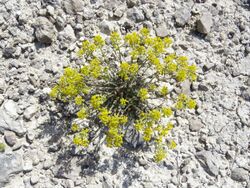Biology:Alyssum serpyllifolium
| Alyssum serpyllifolium | |
|---|---|

| |
| Near Madrid, Spain | |
| Scientific classification | |
| Kingdom: | Plantae |
| Clade: | Tracheophytes |
| Clade: | Angiosperms |
| Clade: | Eudicots |
| Clade: | Rosids |
| Order: | Brassicales |
| Family: | Brassicaceae |
| Genus: | Alyssum |
| Species: | A. serpyllifolium
|
| Binomial name | |
| Alyssum serpyllifolium | |
| Synonyms[1] | |
|
List
| |
Description
Alyssum serpyllifolium, the thyme-leaved alison, is a species of flowering plant in the family Brassicaceae, native to the western Mediterranean region.[2][1] It is adapted to serpentine soils.[3] The Royal Horticultural Society recommends it for rock gardens.[4] The flower color is yellow with green stems. Consists of lance-shaped leaves and It's soil requires dry areas, as well as drained areas. This plant is often used to help observe the relationship between hyperaccumulating plants which store and absorb metals in their tissues, vs. non-hyperaccumulating plants.[5] If soil is contaminated with high concentrations of metals this is likely because of mineral rock weathering or as a result of industrialization.[5] The discovery of the Alyssum plant has led to an easier process of detoxification of plant soil caused by mineral rock weathering or industrialization.[5]
Distribution
It is from the family Brassicaceae and is found in Southwestern Europe. The Alyssum Serpyllifolium is mainly found in the Iberian Peninsula, Northeastern Portugal, and in Spain.[6]
Phytoremediation
One of the features that this plant developed was used to help it adapt to its soil which contains a high concentration of metals. It is considered to be a Metal hyperaccumulator (plants that can tolerate high amounts of metal within their system)[7].This plant was used in a phytoremediation experiment to absorb the metal contaminated soil.[6] A form of phytoremediation is known as phytoextraction, which removes the metals from the contaminated soil by absorbing the metals through the roots.[8] It has the ability to uptake a high concentration of metals. This species of plant is a nickel hyperaccumulator, it mainly absorbs high levels of nickel because of the ultramafic rock found in its environment.[6]
References
- ↑ 1.0 1.1 "Alyssum serpyllifolium Desf." (in en). Royal Botanic Gardens, Kew. http://www.plantsoftheworldonline.org/taxon/277782-1.
- ↑ "Alyssum serpyllifolium thyme-leaved alison". The Royal Horticultural Society. 2022. https://www.rhs.org.uk/plants/26570/i-alyssum-serpyllifolium-i/details. "1 suppliers"
- ↑ Konečná, Veronika; Yant, Levi; Kolář, Filip (2020). "The Evolutionary Genomics of Serpentine Adaptation". Frontiers in Plant Science 11: 574616. doi:10.3389/fpls.2020.574616. PMID 33391295.
- ↑ "Rock gardens: plants". The Royal Horticultural Society. 2022. https://www.rhs.org.uk/plants/for-places/rock-gardens.
- ↑ 5.0 5.1 5.2 Ghaderian, Y. S. Majid; Lyon, Anthony J. E.; Baker, Alan J. M. (2000). "Seedling Mortality of Metal Hyperaccumulator Plants Resulting from Damping off by Pythium spp.". The New Phytologist 146 (2): 219–224. ISSN 0028-646X. https://www.jstor.org/stable/2588971.
- ↑ 6.0 6.1 6.2 Sobczyk, M. K.; Smith, J. a. C.; Pollard, A. J.; Filatov, D. A. (2016-10-16). "Evolution of nickel hyperaccumulation and serpentine adaptation in the Alyssum serpyllifolium species complex" (in en). Heredity 118 (1): 31–41. doi:10.1038/hdy.2016.93. ISSN 1365-2540. PMC 5176119. https://www.nature.com/articles/hdy201693.
- ↑ "Hyperaccumulator - an overview | ScienceDirect Topics". https://www.sciencedirect.com/topics/agricultural-and-biological-sciences/hyperaccumulator#:~:text=Hyperaccumulators%20are%20plants%20that%20can,amounts%20of%20such%20heavy%20metals..
- ↑ Peuke, Andreas D.; Rennenberg, Heinz (2005-06-06). "Phytoremediation". EMBO Reports 6 (6): 497–501. doi:10.1038/sj.embor.7400445. ISSN 1469-221X. PMID 15940279. PMC 1369103. https://www.ncbi.nlm.nih.gov/pmc/articles/PMC1369103/.
Further reading
- Álvarez-López, V.; Puschenreiter, M.; Santner, J.; Lehto, N.; Prieto-Fernández, Á.; Wenzel, W.W.; Monterroso, C.; Kidd, P.S. (2021). "Evidence for nickel mobilisation in rhizosphere soils of Ni hyperaccumulator Odontarrhena serpyllifolia". Plant and Soil 464 (1): 89–107. doi:10.1007/s11104-021-04944-7. ISSN 1573-5036.
- Manteca-Bautista, David; Pérez-Latorre, Andrés V.; Freitas, Helena; Hidalgo-Triana, Noelia (2022). "Metal accumulation by Alyssum serpyllifolium subsp. malacitanum Rivas Goday (Brassicaceae) across different petrographic entities in South-Iberian ultramafic massifs: plant-soil relationships and prospects for phytomining". International Journal of Phytoremediation 24 (12): 1301–1309. doi:10.1080/15226514.2021.2025206. PMID 35019784.
- Pollard, A. Joseph; McCartha, Grace L.; Quintela-Sabarís, Celestino; Flynn, Thomas A.; Sobczyk, Maria K.; Smith, J. Andrew C. (2021). "Intraspecific Variation in Nickel Tolerance and Hyperaccumulation among Serpentine and Limestone Populations of Odontarrhena serpyllifolia (Brassicaceae: Alysseae) from the Iberian Peninsula". Plants 10 (4): 800. doi:10.3390/plants10040800. PMID 33921686.
Wikidata ☰ Q5671359 entry
 |

